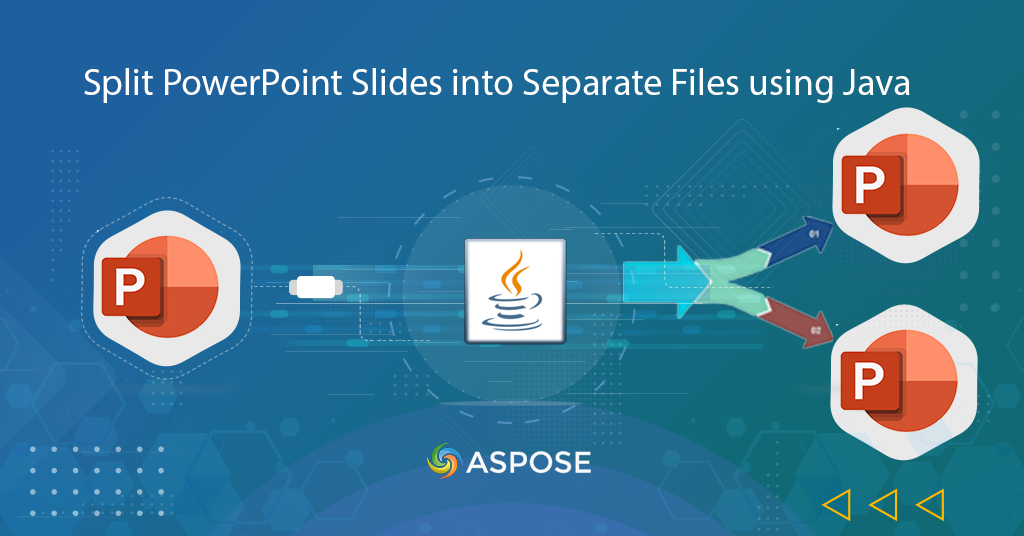
Split PowerPoint slides into separate files in Java
Delivering a concise and focused presentation is essential to engage your audience. However, managing large PowerPoint presentations with numerous slides can be challenging, especially when you need to extract specific sections or create customized presentations. This is where the need for a powerful feature like splitting PowerPoint presentations arises. In this article, we are going to explore the details on how to break down a lengthy presentations into smaller, more manageable parts, so that we can enhance collaboration, streamline editing processes, and create tailored presentations for different audiences.
- Java Cloud SDK for PowerPoint Processing
- Split PowerPoint Presentation with Java
- Split PPT using cURL Commands
Java Cloud SDK for PowerPoint Processing
When it comes to splitting PowerPoint presentations, Aspose.Slides Cloud SDK for Java offers a comprehensive set of tools and features to streamline the process. This powerful SDK allows you to manipulate your presentations with ease and precision. Beyond just splitting presentations, Aspose.Slides Cloud SDK provides a wide range of capabilities that enable you to create, modify, and convert PowerPoint files programmatically.
Now in order to use the SDK, we need to add the following information in pom.xml of the maven build type project.
<repositories>
<repository>
<id>aspose-cloud</id>
<name>artifact.aspose-cloud-releases</name>
<url>http://artifact.aspose.cloud/repo</url>
</repository>
</repositories>
<dependencies>
<dependency>
<groupId>com.aspose</groupId>
<artifactId>aspose-slides-cloud</artifactId>
<version>22.4.0</version>
</dependency>
</dependencies>
Secondl, in order to use the Java REST API, we also need to create a free account by visiting cloud dashboard. If you have GitHub or Google account, simply Sign Up and obtain your client credentials.
Split PowerPoint Presentation with Java
Please follow the instructions given below to split PowerPoint slides into separate files.
- Create an instance of SlidesApi class while passing client credentials as arguments.
- Secondly, create an object of File and load the input PowerPoint presentation.
- Transform the PowerPoint content to Byte[] array using readAllBytes(…) method.
- Now call the API splitOnline(…) to split slides between particular indexes to separate presentations.
- Finally, print the path/location of the resultant .zip archive containing individual Presentations.
Split PPT using cURL Commands
In addition to using Java Cloud SDK, you can also accomplish the task of splitting PowerPoint presentations using cURL commands. This approach offers a lightweight and flexible solution that allows you to interact with the Aspose.Slides Cloud API directly from the command line or within your scripts.
Now in order to use this technique, we need to first generate the JWT access token using client credentials. Please execute the following command to generate the JWT token:
curl -v "https://api.aspose.cloud/connect/token" \
-X POST \
-d "grant_type=client_credentials&client_id=bbf94a2c-6d7e-4020-b4d2-b9809741374e&client_secret=1c9379bb7d701c26cc87e741a29987bb" \
-H "Content-Type: application/x-www-form-urlencoded" \
-H "Accept: application/json"
Once we have the JWT token, please execute the following cURL command to split the input PowerPoint from pages 2 to 3 and save them as separate document.
curl -v -X POST "https://api.aspose.cloud/v3.0/slides/split/Ppt?from=2&to=3" \
-H "accept: multipart/form-data" \
-H "authorization: Bearer <JWT Token>" \
-H "Content-Type: multipart/form-data" \
-d {"document":{input.pptx}}
Conclusion
In this article, we have learned the details of how to Split PowerPoint Slides into separate files using Cloud SDK. We have specifically explored the details on how to programmatically split PPT using Java code snippets as well as how ppt split operation can be performed using the cURL Commands. Please note the complete source code of cloud SDK is available for download over GitHub and you can modify it as per your requirements. Furthermore, if you encounter any issues while using the SDK or you have any further queries, please feel free to contact us via the free product support forum.
Related Articles
We highly recommend visiting the following links to learn about: